On the Use of Advanced Friction Models for the Simulation of an Industrial Stamping Process including the Analysis of Material and Lubricant Fluctuations
Abstract
:1. Introduction
2. Methodology
2.1. Sheet Material
2.2. Mechanical Characterisation
2.3. Topography Analysis
- Average roughness (Sa). The arithmetic mean of the absolute value of the height within the surface. It is the most commonly used parameter to assess surface topography, together with the two-dimensional roughness parameter Ra.
- Root mean square roughness (Sq). A measurement of the asymmetry of the surface deviation about the mean plane.
- Maximum height (Sz). The sum of the maximum value of the surface peak height and the maximum value of the surface valley within the defined area.
- Skewness (Ssk): The degree of bias of the roughness shape, i.e., the asperity of the surface. A positive skewness gives rise to a surface with more peaks or asperities, whereas a negative skewness leads to more valleys.
2.4. Experimental Measurements
2.5. Strip Drawing Tests
2.6. Tribological Models
- Constant. In most industrial simulations, a Coulomb constant model is used for steel deep drawing. In this work, the typical constant value of 0.15 was applied so as to compare with the remaining models.
- Pressure and velocity dependent (P-v dependent). Several studies have demonstrated the influence of contact pressure and sliding velocity on the friction coefficient [4,5,8,10]. In this work, a pressure- and velocity-dependent friction model to calculate the effective coefficient of friction was assumed (Equation (2)) following the potential distribution of Filzek [4]:where is the base friction coefficient, is the contact pressure, is the reference pressure, is the velocity of the sheet relative to the tool in contact, is the reference velocity, and a and e are the velocity factor and pressure exponent, respectively. This model takes into account the decrease in the friction coefficient due to the increase in relative velocity and contact pressure between the sheet and tool in contact. In this work, three P-v-dependent models were implemented for the following amounts of lubricant: 1, 2.4, and 4 g/m2. The maximum, minimum, and mean lubricant amount values were selected to analyze the differences in the tribological models for these boundary values. For simulation, a P-v-dependent single model with a medium level of lubricant was defined, as AutoForm is not able to create different models for each side of the sheet for this tribological model type. Therefore, a simulation model with a P-v-dependent 2.4 g/m2 model was implemented. The average between the two faces was considered for each measured zone, and it was assumed that the P-v-dependent model for the average amount of lubricant was an appropriate approximation.
- TriboForm with lubrication zones. In this case, TriboForm® software was used to create a contact-pressure- and sliding-velocity-dependent model. This model also considers material elasto-plasticity and tool roughness. AutoForm has a TriboForm plug-in that permits implementation of this complex model. It can also define different amounts of lubricant in various zones and sides of the sheet by means of lubrication spots. Nine lubrication zones were defined for each zone and side of the sheet to replicate industrial conditions. These amounts of lubricant were measured in the industrial precut. Three tribological models were defined for three lubricant levels based on the industrial measurements: 1, 2.4, and 4 g/m2. As for the P-v-dependent models, the maximum, minimum, and mean values were selected to analyze the differences between models. To feed the simulation model, the TriboForm 1 g/m2 model was used as the basis. Additional amounts of lubricant were applied to the different zones and sides of the sheet based on experimental measurements with lubrication spots.
2.7. Simulation Set-Up
3. Results
3.1. Tensile Tests and FLDs
3.2. Topography Analysis
3.3. Strip Drawing Tests
3.4. Tribological Models
- Pressure and velocity dependent (P-v dependent). Figure 8 plots the three P-v-dependent models developed for the minimum (Figure 8a), mean (Figure 8b), and maximum (Figure 8c) amounts of lubricant. As observed in the experimental tests, the CoF presents higher values for lower sliding velocities and lower pressures. The boundaries of all the P-v-dependent models are well defined for small contact pressures (2 MPa), whereas for higher contact pressures there are some disparities with respect to the experimental results. The P-v-dependent models for 1 and 4 g/m2 report a slight overestimation of the CoF for high contact pressures and sliding velocities. As an example, the P-v-dependent model for 4 g/m2 presents a small disparity for a sliding velocity of 150 mm/s, in that it estimates a CoF of 0.55 versus an experimental value of 0.047. The increase in the CoF for 25 MPa and 10 mm/s in 1 and 4 g/m2 lubrication levels cannot be replicated by the P-v-dependent models, which show a maximum deviation of 18% with respect to the experimental value for the 1 g/m2 P-v-dependent model. The coefficients of the P-v-dependent friction models (Equation (2)) were calculated with least squares methodology using Microsoft Excel and are presented in Table 4. The P-v-dependent model for 2.4 g/m2 reported the lowest error, with an RMSE of 0.04 (Table 5) and model boundaries in strong agreement with the experimental results.
- TriboForm with lubrication zones. These models were composed of a cast iron tooling with an average roughness of Sa = 0.65 µm and sheet material with a roughness of Sa = 1.4 μm. The nine lubrication zones defined for each side of the sheet are illustrated in Figure 9. Note that the lubrication scope in the TriboForm library created ranges from 0.5 to 3 g/m2. Hence, zones with amounts of lubricant higher than 3 g/m2 were limited to a maximum of 3 g/m2.
3.5. Numerical Results
3.6. Experimental Measurements
4. Discussion
5. Conclusions
- The use of complex tribological models with the friction coefficient as a function of contact pressure, sliding velocity, and amount of lubricant substantially improved the simulation accuracy compared with the constant model.
- The TriboForm with lubrication zones and P-v-dependent models predicted similar results; the TriboForm model predicted slightly more thickening.
- The constant model predicted a lower draw-in value than the P-v-dependent and TriboForm with lubrication zones models for all points measured. With respect to the experimental results, no clear trend was observed.
- For batches of DC06 mild steel, no significative differences in the friction coefficient were found. This suggests a variation in the roughness of the sheets as an incontrollable noise that is not batch dependent. Nonetheless, this did not significantly affect the friction coefficient results (less than 0.01).
- For the analyzed materials, there were no major differences in the values of the coefficient of friction based on the amount of lubricant applied. The variation in the amount of lubricant (from 0.5 to 4 g/m2) led to maximum CoF variation of 0.014.
Author Contributions
Funding
Data Availability Statement
Acknowledgments
Conflicts of Interest
References
- Tisza, M.; Fulop, T. A general overview of tribology of sheet metal forming. J. Plast. Technol. 2001, 6, 11–25. [Google Scholar]
- Andersson, A. Numerical and experimental evaluation of springback in a front side member. J. Mater. Process. Technol. 2005, 169, 352–356. [Google Scholar] [CrossRef]
- Sigvant, M.; Hol, J.; Chezan, T.; van den Boogaard, T. Friction modelling in sheet metal forming simulations: Application and validation on an U-Bend product. In Advanced Constitutive Models in Sheet Metal Forming; Institute of Virtual Manufacturing: Berlin/Heidelberg, Germany, 2015; pp. 135–142. [Google Scholar]
- Filzek, J.; Ludwig, M.; Groche, P. Improved FEM simulation of sheet metal forming with friction modelling using laboratory tests. In Proceedings of the IDDRG, Bilbao, Spain, 5–8 June 2011. [Google Scholar]
- Gil, I.; Mendiguren, J.; Galdos, L.; Mugarra, E.; de Argandoña, E.S. Influence of the pressure dependent coefficient of friction on deep drawing springback predictions. Tribol. Int. 2016, 103, 266–273. [Google Scholar] [CrossRef]
- de Argandoña, E.S.; Zabala, A.; Galdos, L.; Mendiguren, J. The effect of material surface roughness in aluminum forming. Procedia Manuf. 2020, 47, 591–595. [Google Scholar] [CrossRef]
- Hol, J.; Wiebenga, J.H.; Carleer, B. Friction and lubrication modelling in sheet metal forming: Influence of lubrication amount, tool roughness and sheet coating on product quality. J. Phys. Conf. 2017, 896, 12026. [Google Scholar] [CrossRef]
- Filzek, J.; Keil, D.; Schröder, H. Temperature Induced Friction Increase in Friction Test and Forming Demonstrator for Sheet Metal Forming. In Proceedings of the 24th International Conference on Material Forming (ESAFORM 2021), Liège, Belgium, 14–16 April 2021. [Google Scholar]
- Aha, B.; Hettich, D.; Veldhuis, M.; Filzek, J. Higher Productivity in Forming High-alloyed Steel by Temperature Insensitive Friction Behavior. In Proceedings of the 24th International Conference on Material Forming (ESAFORM 2021), Liège, Belgium, 14–16 April 2021. [Google Scholar]
- Zabala, A.; de Argandoña, E.S.; Cañizares, D.; Llavori, I.; Otegi, N.; Mendiguren, J. Numerical study of advanced friction modelling for sheet metal forming: Influence of the die local roughness. Tribol. Int. 2021, 165, 107259. [Google Scholar] [CrossRef]
- Sigvant, M.; Pilthammar, J.; Hol, J.; Wiebenga, J.H.; Chezan, T.; Carleer, B.; Van Den Boogaard, T. Friction in sheet metal forming: Influence of surface roughness and strain rate on sheet metal forming simulation results. Procedia Manuf. 2019, 29, 512–519. [Google Scholar] [CrossRef]
- Zabala, A.; Galdos, L.; Childs, C.; Llavori, I.; Aginagalde, A.; Mendiguren, J.; de Argandoña, E.S. The interaction between the sheet/tool surface texture and the friction/galling behaviour on aluminium deep drawing operations. Metals 2021, 11, 979. [Google Scholar] [CrossRef]
- Merklein, M.; Zoeller, F.; Sturm, V. Experimental and numerical investigations on frictional behaviour under consideration of varying tribological conditions. Adv. Mater. Res. 2014, 966, 270–278. [Google Scholar] [CrossRef]
- Sigvant, M.; Pilthammar, J.; Hol, J.; Wiebenga, J.H.; Chezan, T.; Carleer, B.; Boogaard, A.H.V.D. Friction in Sheet Metal Forming Simulations: Modelling of New Sheet Metal Coatings and Lubricants. IOP Conf. Ser. Mater. Sci. Eng. 2018, 418, 012093. [Google Scholar] [CrossRef]
- Dou, S.; Xia, J. Analysis of sheet metal forming (Stamping process): A study of the variable friction coefficient on 5052 aluminum alloy. Metals 2019, 9, 853. [Google Scholar] [CrossRef]
- Galdos, L.; Trinidad, J.; Otegi, N.; Garcia, C. Friction Modelling for Tube Hydroforming Processes—A Numerical and Experimental Study with Different Viscosity Lubricants. Materials 2022, 15, 5655. [Google Scholar] [CrossRef] [PubMed]
- Harsch, D.; Heingärtner, J.; Hortig, D.; Hora, P. Process Windows for Sheet Metal Parts based on Metamodels. J. Phys. Conf. Ser. 2016, 734, 32014. [Google Scholar] [CrossRef]
- Harsch, D.; Heingärtner, J.; Renkci, Y.; Hora, P. Influence of scattering material properties on the robustness of deep drawing processes. In Proceedings of the Forming Technology Forum 2017, Enschede, The Netherlands, 12–13 October 2017. [Google Scholar]
- Tatipala, S.; Wall, J.; Johansson, C.M.; Sigvant, M. Data-driven modelling in the era of Industry 4.0: A case study of friction modelling in sheet metal forming simulations. J. Phys. Conf. Ser. 2018, 1063, 012135. [Google Scholar] [CrossRef]
- Sigvant, M.; Pilthammar, J.; Hol, J.; Wiebenga, J.H.; Chezan, T.; Carleer, B.; Boogaard, A.H.V.D. Friction and lubrication modelling in sheet metal forming simulations of the Volvo XC90 inner door. J. Phys. Conf. Ser. 2016, 734, 32090. [Google Scholar] [CrossRef]
- Hora, P.; Heingärtner, J.; Manopulo, N.; Tong, L. Zero Failure Production Methods Based on a Process Integrated Virtual Control. In Proceedings of the 8th International Conference and Workshop on Numerical Simulation of 3D Sheet Metal Forming Processes, Seoul, Republic of Korea, 21–26 August 2011; Volume 47, pp. 35–47. [Google Scholar] [CrossRef]
- Aspinwall, D.K.; Wise, M.L.H.; Stout, K.J.; Goh, T.H.A.; Zhao, F.L.; El-Menshawy, M.F. Electrical discharge texturing. Int. J. Mach. Tools Manuf. 1992, 32, 183–193. [Google Scholar] [CrossRef]
- GOM. ARAMIS [www Document]. 2020. Available online: https://www.gom.com/en/products/3d-testing (accessed on 9 February 2021).
- Panich, S.; Barlat, F.; Uthaisangsuk, V.; Suranuntchai, S.; Jirathearanat, S. Experimental and theoretical formability analysis using strain and stress based forming limit diagram for advanced high strength steels. Mater. Des. 2013, 51, 756–766. [Google Scholar] [CrossRef]
- Bleck, W.; Deng, Z.; Papamantellos, K.; Gusek, C.O. A comparative study of the forming-limit diagram models for steel sheets. J. Mater. Process. Technol. 1998, 83, 223–230. [Google Scholar] [CrossRef]
- Pereira, M.P.; Yan, W.; Rolfe, B.F. Contact pressure evolution and its relation to wear in sheet metal forming. Wear 2008, 265, 1687–1699. [Google Scholar] [CrossRef]
- UNE-EN ISO 25178-2; Especificacion Geometrica de Productos (GPS). Calidad Superficial: Areas. Parte 2: Terminos, Definiciones y Parametos de Calidad Superficial. AENOR: Madrid, Spain, 2013.
- Swift, H.W. Plastic instability under plane stress. J. Mech. Phys. Solids 1952, 1, 1–18. [Google Scholar] [CrossRef]
- Banabic, D. Sheet Metal Forming Processes; Springer: Berlin/Heidelberg, Germany, 2016; Volume 53. [Google Scholar] [CrossRef]
- AutoForm Engineering GmbH. AutoForm R10 Software Manual; AutoForm Engineering GmbH: Freienbach, Switzerland, 2022. [Google Scholar]
- Altan, T.; Tekkaya, E. Sheet Metal Forming: Fundamentals; ASTM International: West Conshohocken, PA, USA, 2012. [Google Scholar]
- Trzepieciński, T.; Bazan, A.; Lemu, H.G. Frictional characteristics of steel sheets used in automotive industry. Int. J. Automot. Technol. 2015, 16, 849–863. [Google Scholar] [CrossRef]
- Kosanov, J.; Lenard, J.G.; Uhrig, J.; Wallfarth, B. The effect of lubricant additives on the coefficient of friction in the flat-die test. Mater. Sci. Eng. A 2006, 427, 274–281. [Google Scholar] [CrossRef]
- Hansen, B.; Purr, S.; Meinhardt, J.; Merklein, M. Investigation of the tribological behavior of car body parts in series production. Procedia Manuf. 2019, 27, 51–56. [Google Scholar] [CrossRef]
- Karupannasamy, D.K.; De Rooij, M.B.; Schipper, D.J. Multi-scale friction modelling for rough contacts under sliding conditions. Wear 2013, 308, 222–231. [Google Scholar] [CrossRef]
- Guo, B.; Gong, F.; Wang, C.J.; Shan, D.B. Flow stress and tribology size effects in scaled down cylinder compression. Trans. Nonferrous Met. Soc. China 2009, 19, s516–s520. [Google Scholar] [CrossRef]
- Dubois, A.; Kanim, A.N.M. Metal Forming and Lubrication. Ref. Modul. Mater. Sci. Mater. Eng. 2019, 1, 1–9. [Google Scholar] [CrossRef]
- Recklin, V.; Dietrich, F.; Groche, P. Influence of test stand and contact size sensitivity on the friction coefficient in sheet metal forming. Lubricants 2018, 6, 41. [Google Scholar] [CrossRef]
- Bolay, C.; Essig, P.; Kaminsky, C.; Hol, J.; Naegele, P.; Schmidt, R. Friction modelling in sheet metal forming simulations for aluminium body parts at Daimler AG. IOP Conf. Ser. Mater. Sci. Eng. 2019, 651, 012104. [Google Scholar] [CrossRef]
- Zabala, A.; Llavori, I.; de Argandoña, E.S.; Mendiguren, J. Towards the automation of the die spotting process: Contact blue pattern decryption. J. Manuf. Process. 2020, 58, 1285–1296. [Google Scholar] [CrossRef]
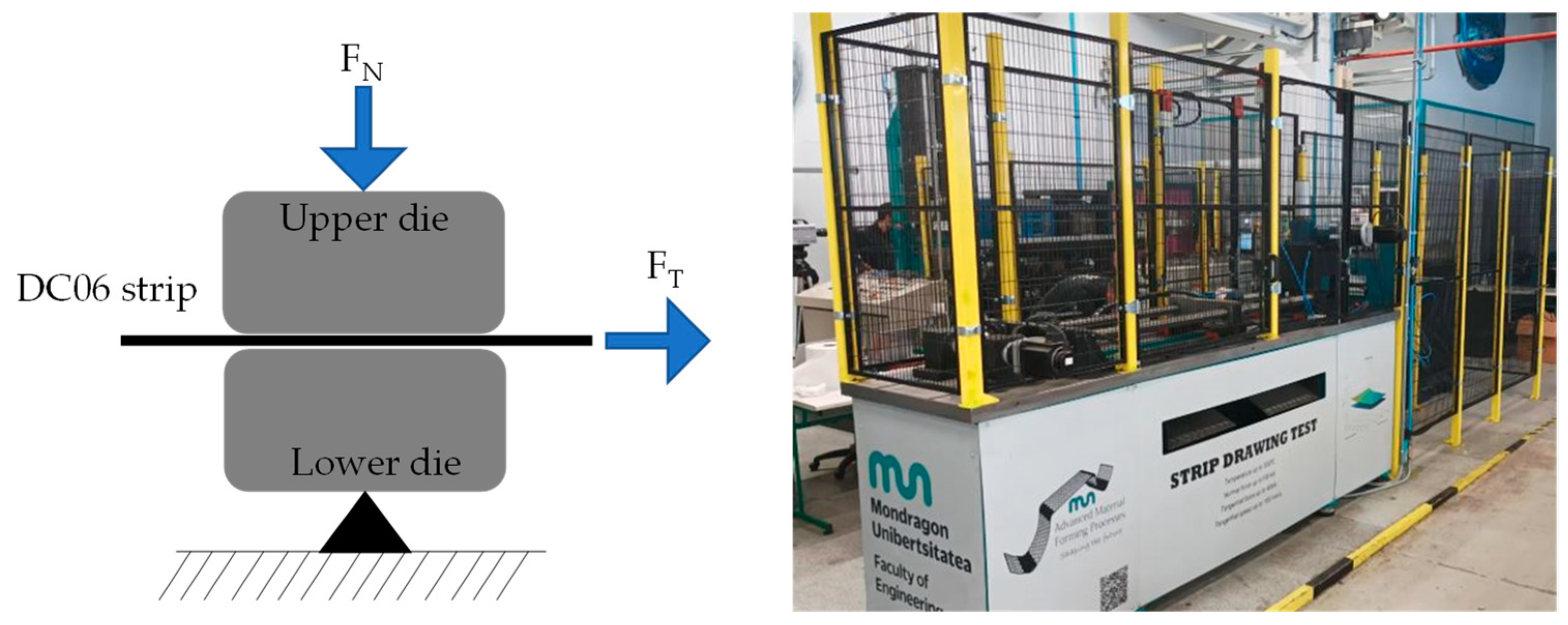


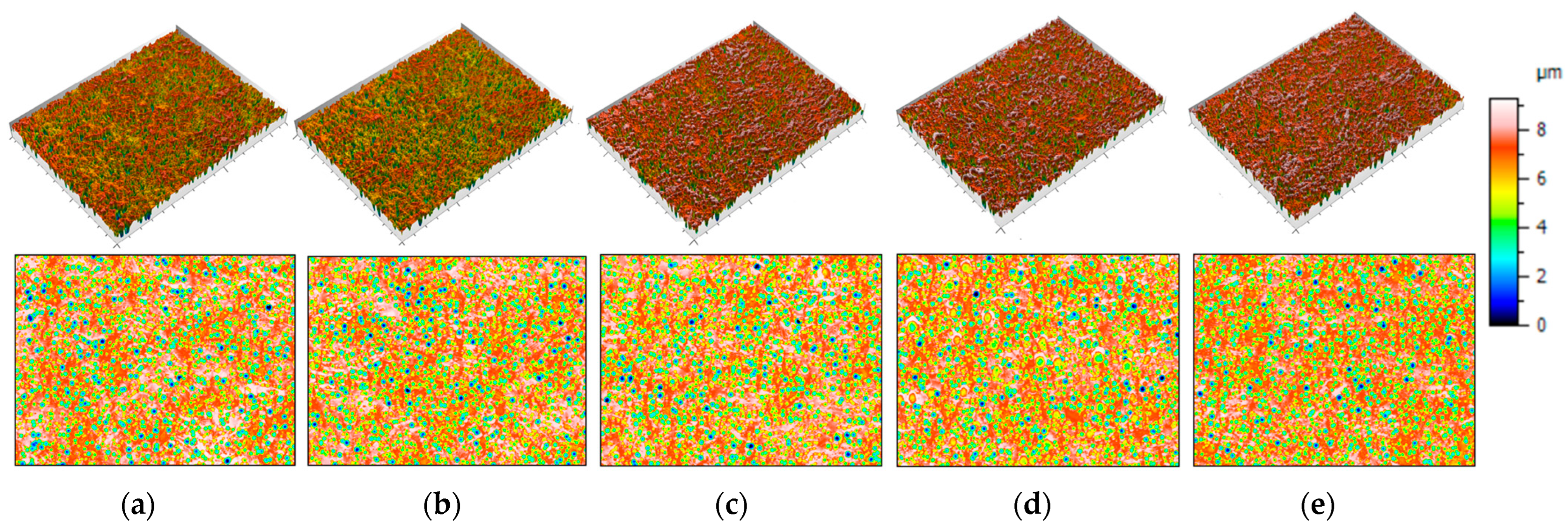

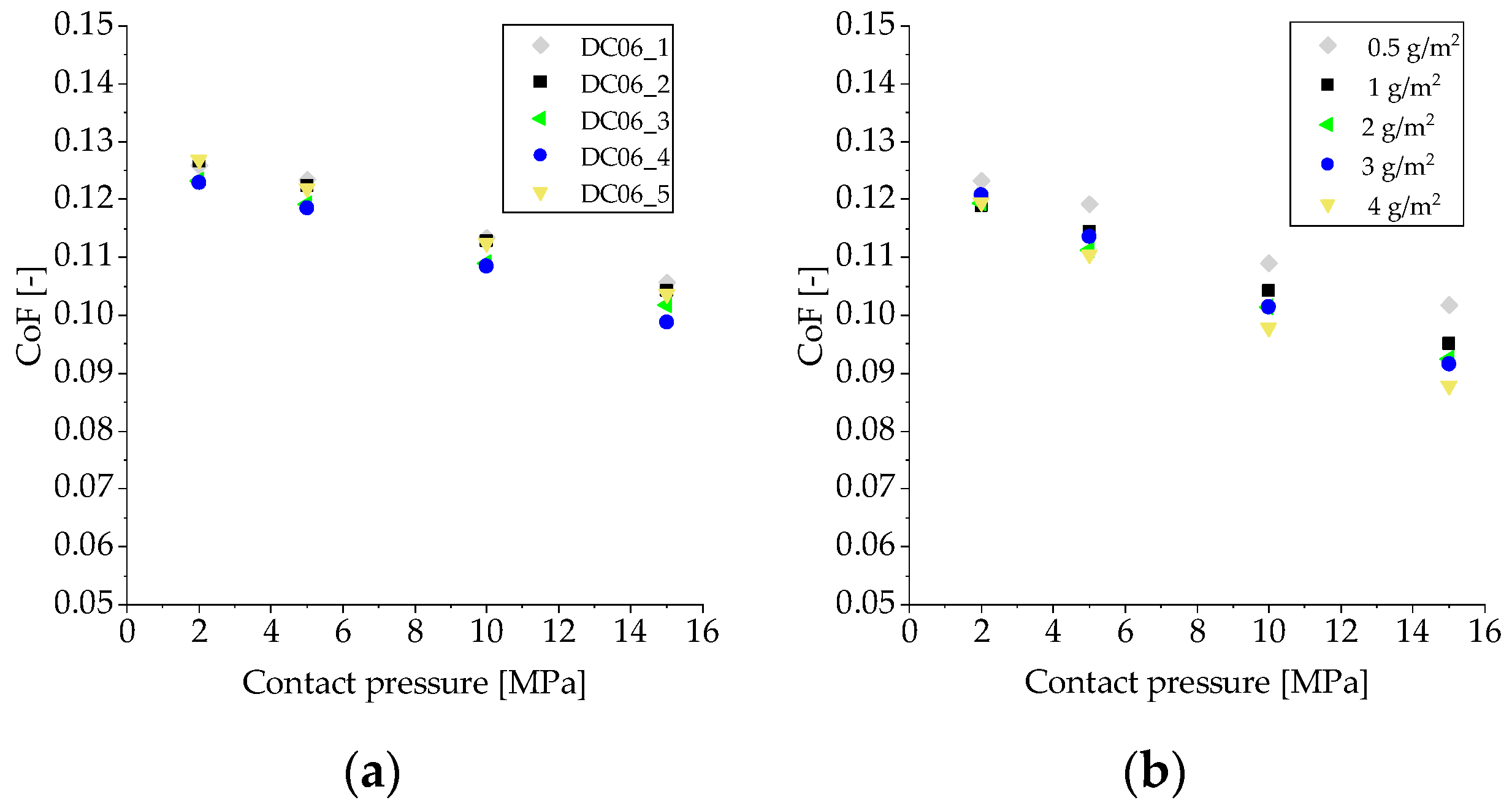
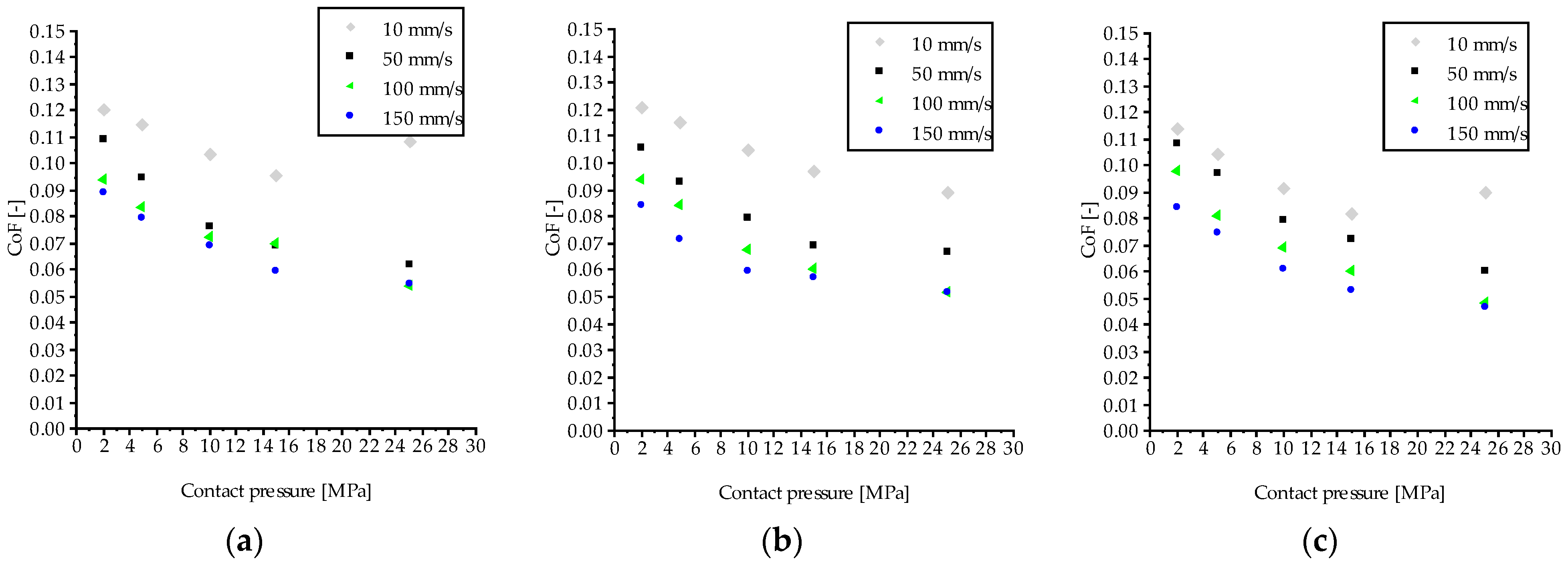

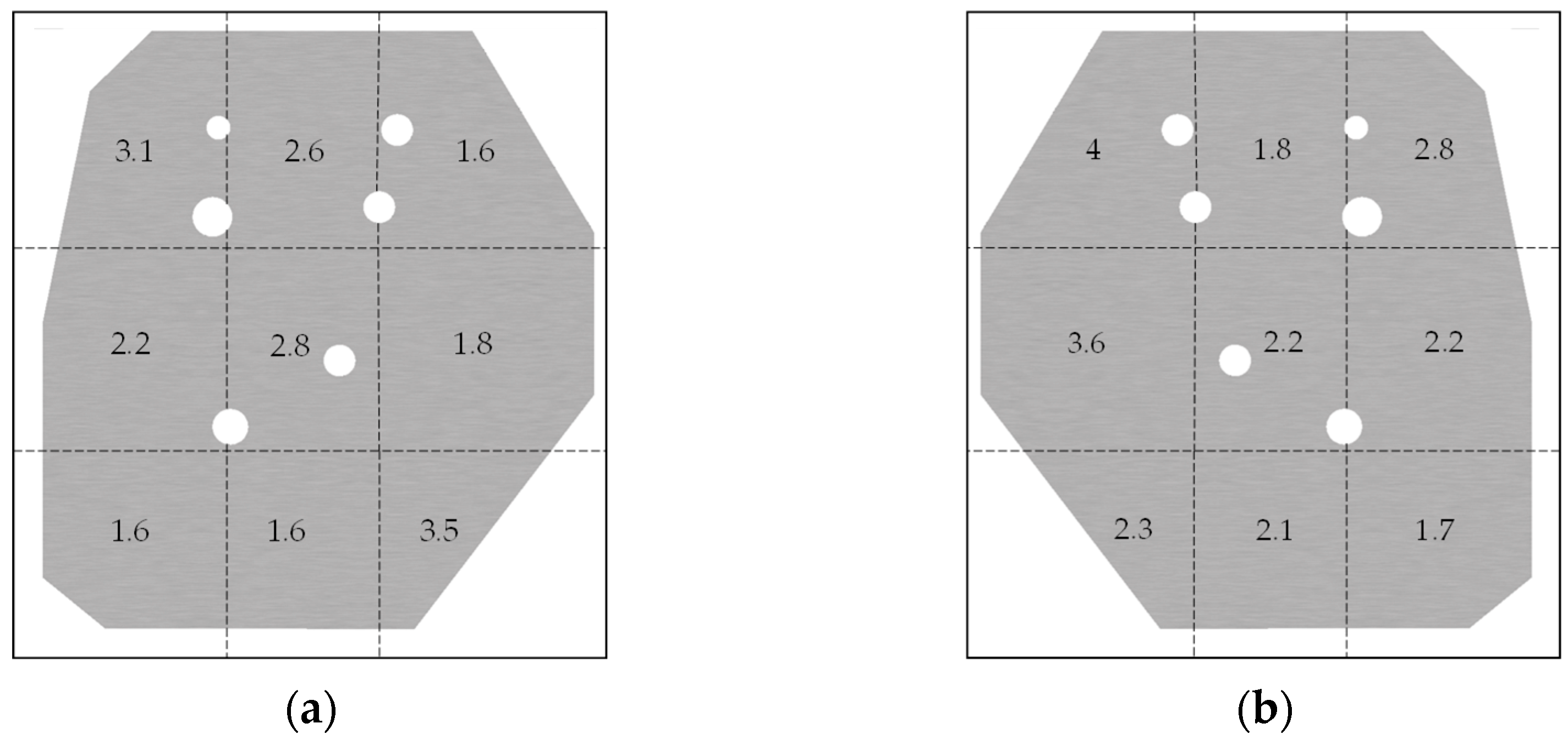



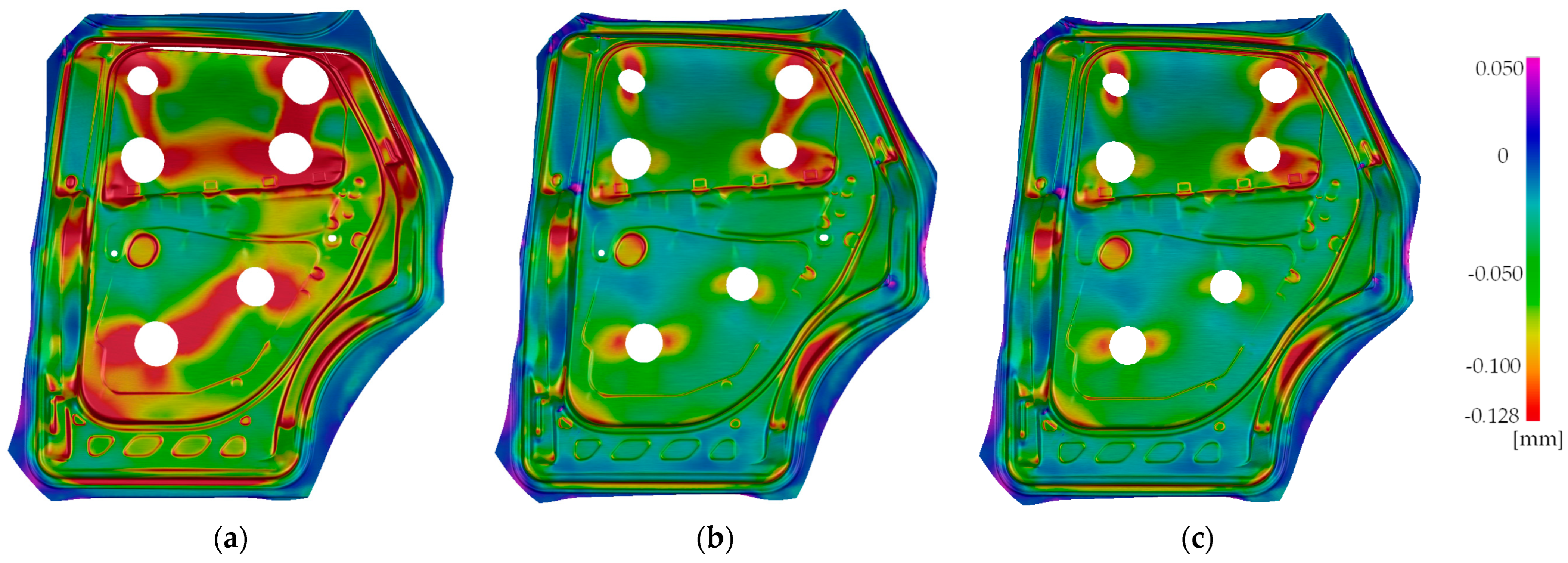
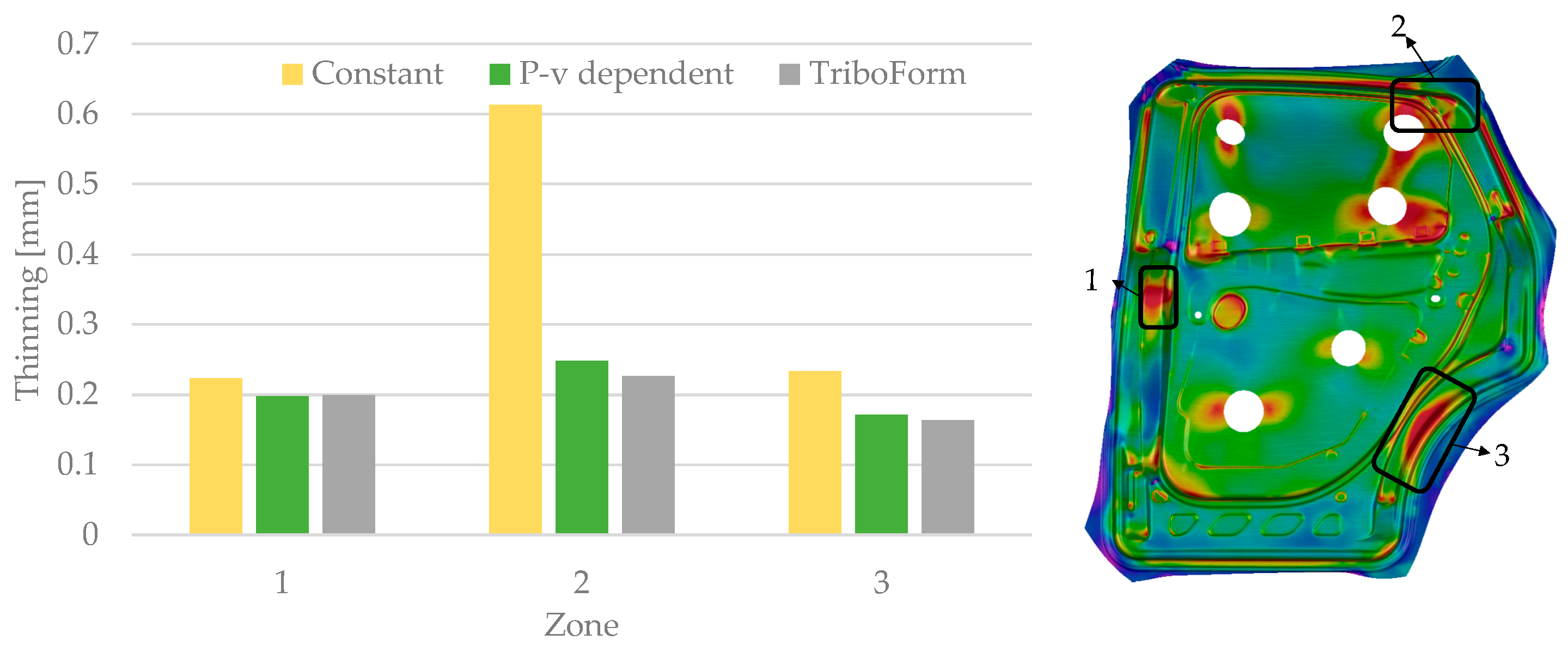
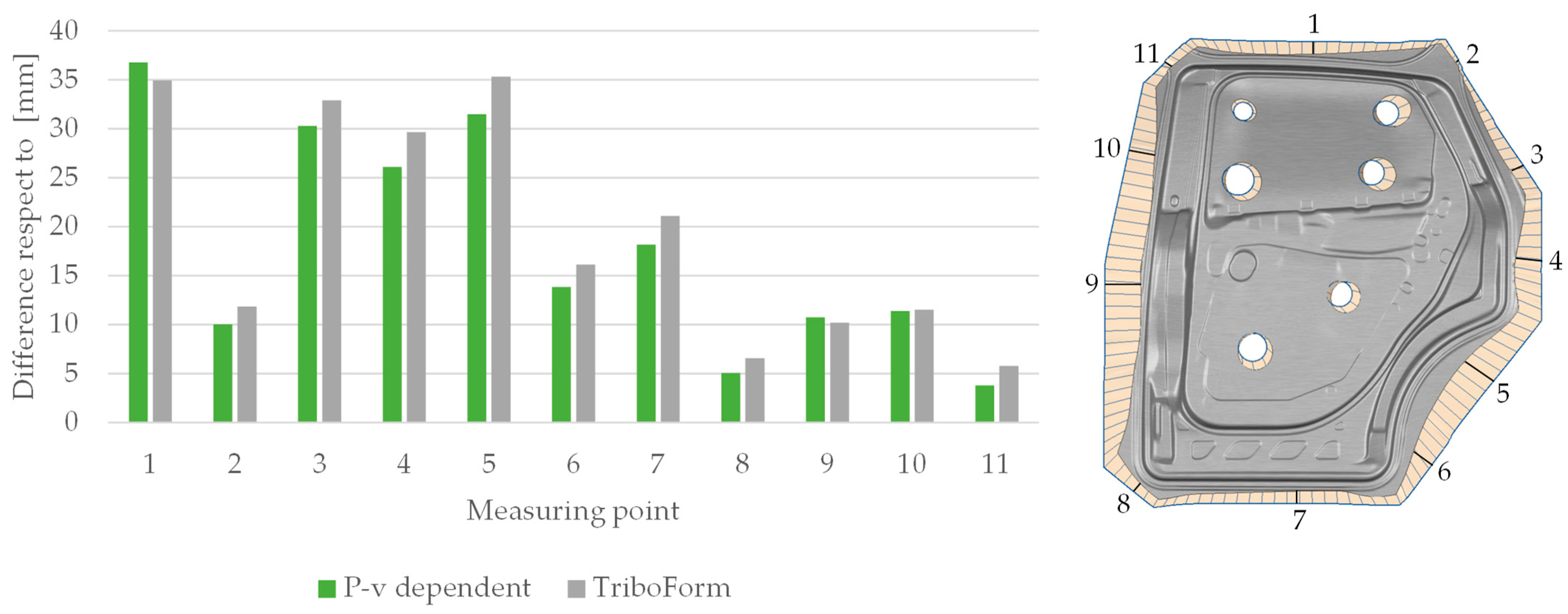
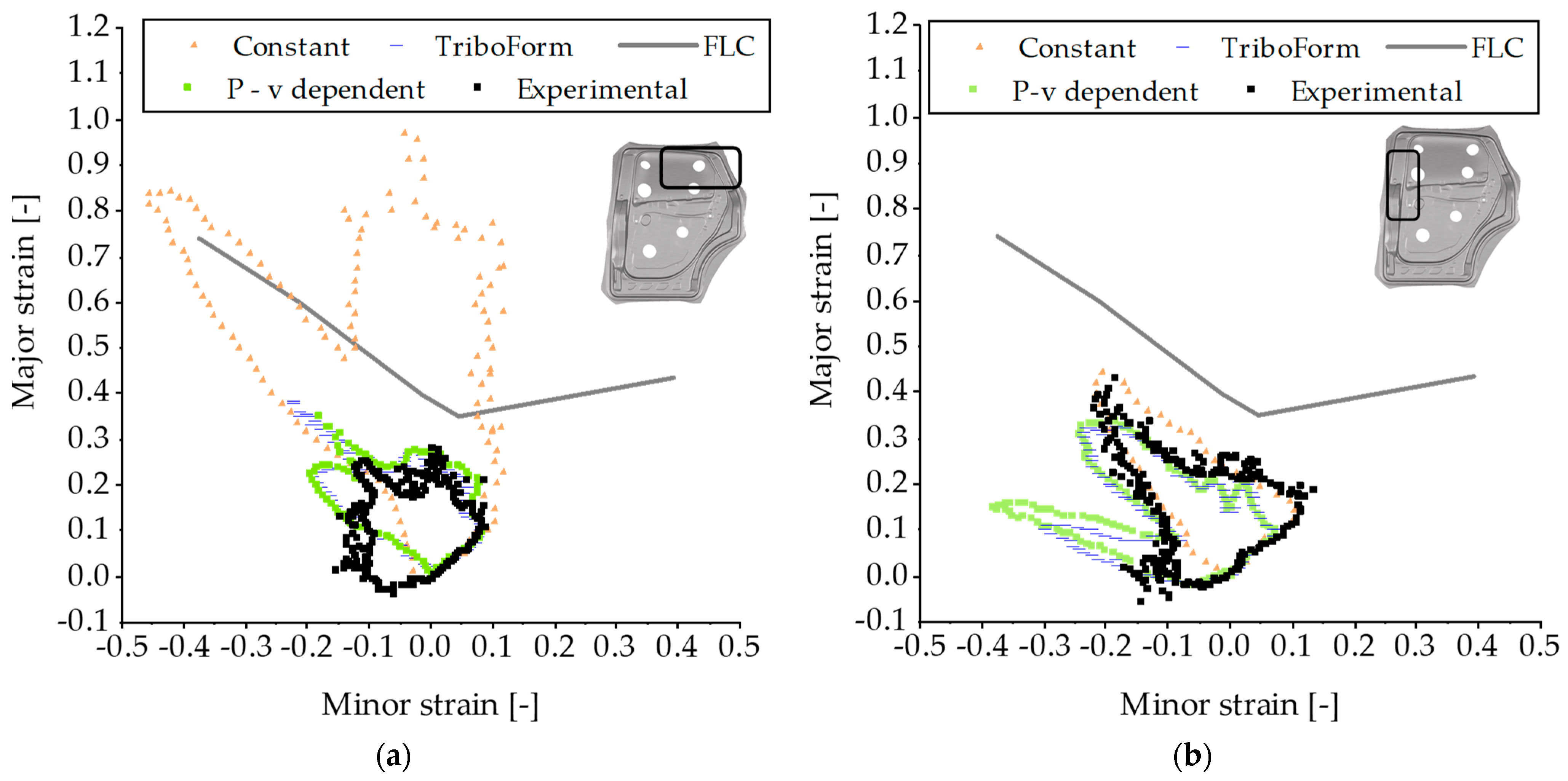
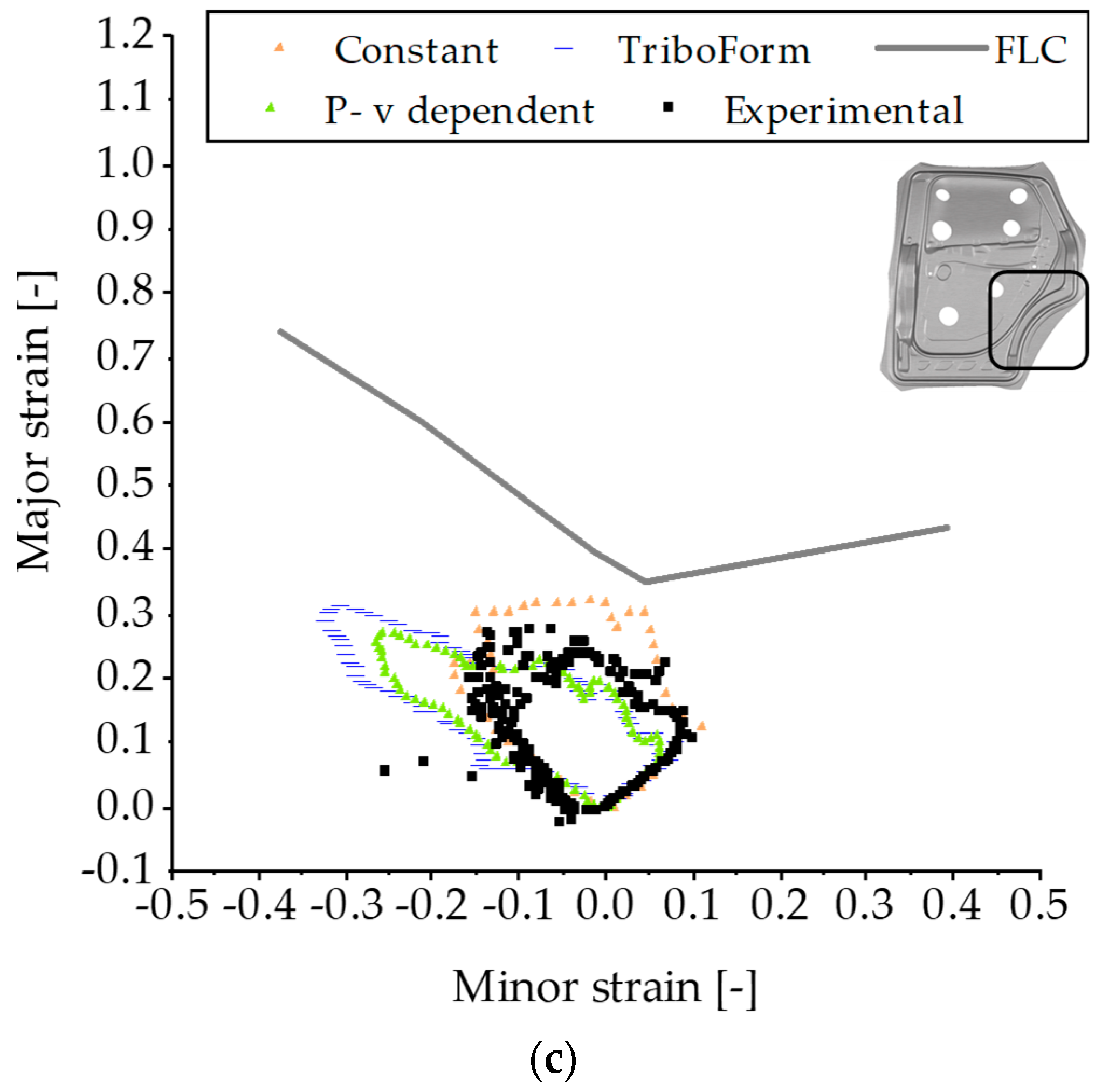


| Factor Affecting CoF | Value |
|---|---|
| Contact pressure [MPa] | 2/5/10/15/25 |
| Sliding velocity [mm/s] | 10/50/100/150 |
| Amount of lubricant [g/m2] | 0.5/1/2/2.4/3/4 |
| Material | DC06 mild steel |
| Sheet thickness | 0.64 mm |
| Poisson ratio | 0.3 |
| Young Modulus | 210 GPa |
| Hardening model | Swift Hockett–Sherby |
| Yield criteria | BBC2005 |
| Blank holder | Force controlled (columns) |
| Spacer blocks | From 0.5 to 0.9 mm |
| Material | Rp 0.2% [MPa] | Rm [MPa] | r0 [-] | r45 [-] | r90 [-] | n [-] |
|---|---|---|---|---|---|---|
| DC06_1 | 156.9 | 294.5 | 2.110 | 1.837 | 2.560 | 0.247 |
| DC06_2 | 140.0 | 280.9 | 2.060 | 1.877 | 2.820 | 0.248 |
| DC06_3 | 147.4 | 293.3 | 2.043 | 1.680 | 2.493 | 0.243 |
| DC06_4 | 151.4 | 296.5 | 2.050 | 1.910 | 2.640 | 0.250 |
| DC06_5 | 152.4 | 292.9 | 2.013 | 1.647 | 2.420 | 0.240 |
| Model | e | a | pref [MPa] | vref [mm/s] |
|---|---|---|---|---|
| P-v dependent 1 g/m2 | 0.8767 | 0.0116 | 1.9771 | 10 |
| P-v dependent 2.4 g/m2 | 0.8817 | 0.0138 | 1.9901 | 10 |
| P-v dependent 4 g/m2 | 0.8664 | 0.0108 | 1.9704 | 10 |
| Model | Amount of Lubricant [g/m2] | R-Squared [-] | RMSE [-] |
|---|---|---|---|
| P-v dependent | 1 | 0.895 | 0.006 |
| 2.4 | 0.963 | 0.004 | |
| 4 | 0.915 | 0.006 | |
| TriboForm | 1 | 0.870 | 0.007 |
| 2.4 | 0.969 | 0.004 | |
| 4 | 0.941 | 0.005 |
Disclaimer/Publisher’s Note: The statements, opinions and data contained in all publications are solely those of the individual author(s) and contributor(s) and not of MDPI and/or the editor(s). MDPI and/or the editor(s) disclaim responsibility for any injury to people or property resulting from any ideas, methods, instructions or products referred to in the content. |
© 2023 by the authors. Licensee MDPI, Basel, Switzerland. This article is an open access article distributed under the terms and conditions of the Creative Commons Attribution (CC BY) license (https://creativecommons.org/licenses/by/4.0/).
Share and Cite
Muñiz, L.; Trinidad, J.; Garcia, E.; Peinado, I.; Montes, N.; Galdos, L. On the Use of Advanced Friction Models for the Simulation of an Industrial Stamping Process including the Analysis of Material and Lubricant Fluctuations. Lubricants 2023, 11, 193. https://doi.org/10.3390/lubricants11050193
Muñiz L, Trinidad J, Garcia E, Peinado I, Montes N, Galdos L. On the Use of Advanced Friction Models for the Simulation of an Industrial Stamping Process including the Analysis of Material and Lubricant Fluctuations. Lubricants. 2023; 11(5):193. https://doi.org/10.3390/lubricants11050193
Chicago/Turabian StyleMuñiz, Laura, Javier Trinidad, Eduardo Garcia, Ivan Peinado, Nicolas Montes, and Lander Galdos. 2023. "On the Use of Advanced Friction Models for the Simulation of an Industrial Stamping Process including the Analysis of Material and Lubricant Fluctuations" Lubricants 11, no. 5: 193. https://doi.org/10.3390/lubricants11050193







